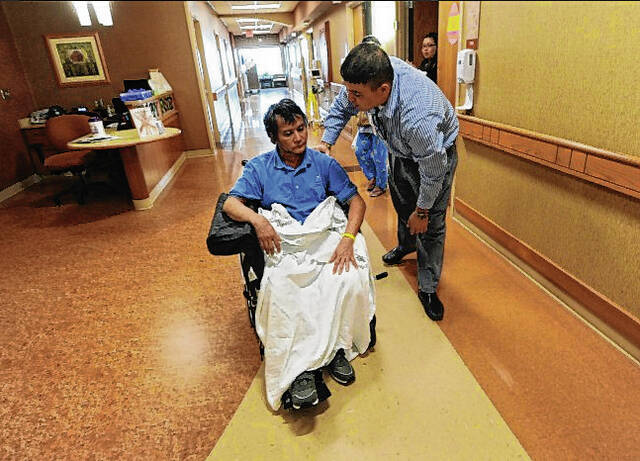Navigating the health care system can be a confusing and overwhelming experience for anyone.
But for many of the approximately 25,000 Burmese refugees in central Indiana, those challenges are nearly impossible to surpass.
“They have to learn a new culture, new languages. It is very hard for them to understand, and for them to learn a new language,” said Nancy Sui, a Burmese community advocate for Franciscan Health. “Many Burmese people do not know what they have access to.”
For many in the growing Burmese population on the southside of Indianapolis, even accessing basic health care is extremely difficult. Franciscan Health Indianapolis officials hope a new outreach can help Burmese refugees living in the area to access primary care, prenatal services, preventative medicine and more.
The hospital system, through the Franciscan Health Foundation, is adding a designated Burmese Community Health Worker, made possible with a nearly $185,000 grant from the Cigna Foundation. The community health worker will provide culturally appropriate one-on-one assistance for clients to guide them through their health care needs.
Those who work closely with the Burmese population in the area see it as a gateway to better opportunities and more robust lives.
“This grant really helps us target the (Burmese) population in the way it should be targeted, from those who may know best,” said Juanita Fitzgerald, community health improvement manager for the Franciscan Health Foundation.
Since the early 2000s, the Indianapolis area has become home to one of the largest populations of Burmese refugees in the world. Many of these refugees are Chins, an ethnic minority in Burma, or Myanmar, that faced political, social and religious persecution from the military dictatorship ruling the country.
Indianapolis is home to an estimated 25,000 refugees from Myanmar. Many of those people have settled in Perry Township on the southside of Indianapolis, as well as in northern Johnson County.
In fleeing their homeland, the Burmese people have found safety and support in Indiana. But the population still faces immense challenges in their day-to-day lives. Of all of the Asian-American groups living across the nation, Burmese households have the highest poverty rate at 45%, the lowest annual income —$36,000 — and the lowest rate of English proficiency at 28%.
Research shows that socioeconomic status and language barriers contribute to health disparities among ethnic minorities, including the Burmese.
“What I’ve learned is translation and language are huge barriers in the community. Most of them are of the older generation,” Fitzgerald said. “We’re really committed to the health of the most vulnerable in our community.”
Burmese refugees also face other barriers to successfully resettling, including lack of access to transportation, healthy food, translation services and language education, and safe housing.
Part of the problem is that there are not nearly enough specially trained professionals to help overcome these challenges, which is why having a designated community health worker was so vital, Sui said.
“We’re hoping they can be the liaison between Franciscan Health and the Burmese community,” Sui said. ”The community health worker will be the main person they can go to for help. They can help them navigate through the health care settings.”
Over the past 10 years, the Franciscan Health Foundation has been active in improving the well-being of the Burmese community in Indianapolis, Fitzgerald said. The foundation supports the growing health care needs of communities and supporting patient needs at Franciscan facilities, including behavioral health, community wellness, and women and children health.
A major focus has been on traditional chronic diseases, such as heart disease and diabetes, that impact older adults.
“One way we want to do that is helping the community understand the importance of physical activity and nutrition, since they go hand in hand,” Fitzgerald said. “We want to get that need-to-know information to the community.”
This grant will only allow the foundation to do even more work, Fitzgerald said. The approximately $184,190 grant is being used to hire a community health worker to work directly with the Burmese population locally.
“She’ll really be the face in the community,” Fitzgerald said. “That face-to-face contact, helping the community to receive that health care they might need. Or overall, just to help them find the right resources at that time.”
Those services aren’t restricted to figuring out solely medical issues, either.
“Things like figuring out food insecurity, transportation, mental health services. The community health worker will be able to figure that out for the population, and really learn and understand what the community needs and is asking for,” Fitzgerald said.
Biak Tha Sui, herself part of the Burmese community, has been chosen to serve as that Burmese Community Health Worker. Initially, she will conduct home visits to those in the Burmese population, supporting them in managing their own health and helping them follow their doctor’s recommendations for healthy lifestyle changes. At the same time, she can provide referrals to community-based resources.
She anticipates serving as a liaison between the Burmese and community health and social service agencies, collaborating with groups such as Hope for Tomorrow and CHIN Community Indiana.
“We will be working with them to find food, safe housing, interpreters and language education, job skills, as well as access to essential healthcare services,” she said.
The foundation also sees Biak Tha Sui offering drop-in hours with the Marion County Health Department, where clients can come to receive help in person.
Though plans on how to offer services are still being finalized, Biak Tha Sui will start outreach in the coming weeks.
“Her being Burmese, it can be more comfortable for people to come to someone who looks like you, who understands the challenges and obstacles,” Fitzgerald said. “She can help them understand how the American medical system works, what it’s like to go to the doctor. She can really help the older generation understand that process and walk through that process.”





